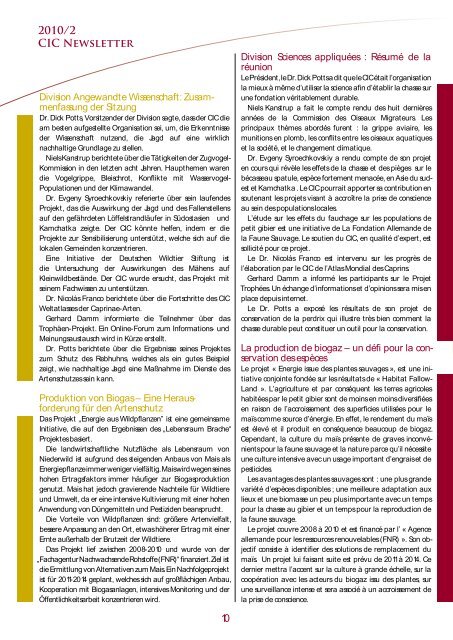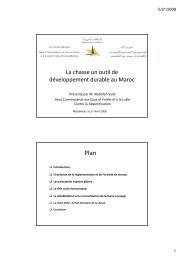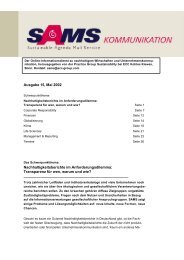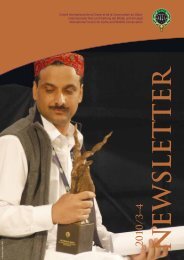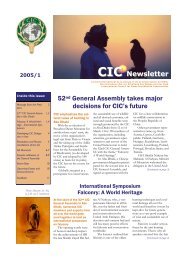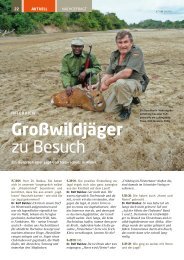Conseil International de la Chasse et de la - International Council for ...
Conseil International de la Chasse et de la - International Council for ...
Conseil International de la Chasse et de la - International Council for ...
You also want an ePaper? Increase the reach of your titles
YUMPU automatically turns print PDFs into web optimized ePapers that Google loves.
2010/2<br />
CIC Newsl<strong>et</strong>ter<br />
Division Angewandte Wissenschaft: Zusammenfassung<br />
<strong>de</strong>r Sitzung<br />
Dr. Dick Potts, Vorsitzen<strong>de</strong>r <strong>de</strong>r Division sagte, dass <strong>de</strong>r CIC die<br />
am besten aufgestellte Organisation sei, um, die Erkenntnisse<br />
<strong>de</strong>r Wissenschaft nutzend, die Jagd auf eine wirklich<br />
nachhaltige Grund<strong>la</strong>ge zu stellen.<br />
Niels Kanstrup bericht<strong>et</strong>e über die Tätigkeiten <strong>de</strong>r Zugvogel-<br />
Kommission in <strong>de</strong>n l<strong>et</strong>zten acht Jahren. Haupthemen waren<br />
die Vogelgrippe, Bleischrot, Konfl ikte mit Wasservogel-<br />
Popu<strong>la</strong>tionen und <strong>de</strong>r Klimawan<strong>de</strong>l.<br />
Dr. Evgeny Syroechkovskiy referierte über sein <strong>la</strong>ufen<strong>de</strong>s<br />
Projekt, das die Auswirkung <strong>de</strong>r Jagd und <strong>de</strong>s Fallenstellens<br />
auf <strong>de</strong>n gefähr<strong>de</strong>ten Löffelstrandläufer in Südostasien und<br />
Kamchatka zeigte. Der CIC könnte helfen, in<strong>de</strong>m er die<br />
Projekte zur Sensibilisierung unterstützt, welche sich auf die<br />
lokalen Gemein<strong>de</strong>n konzentrieren.<br />
Eine Initiative <strong>de</strong>r Deutschen Wildtier Stiftung ist<br />
die Untersuchung <strong>de</strong>r Auswirkungen <strong>de</strong>s Mähens auf<br />
Kleinwildbestän<strong>de</strong>. Der CIC wur<strong>de</strong> ersucht, das Projekt mit<br />
seinem Fachwissen zu unterstützen.<br />
Dr. Nicolás Franco bericht<strong>et</strong>e über die Fortschritte <strong>de</strong>s CIC<br />
Weltat<strong>la</strong>sses <strong>de</strong>r Caprinae-Arten.<br />
Gerhard Damm in<strong>for</strong>mierte die Teilnehmer über das<br />
Trophäen-Projekt. Ein Online-Forum zum In<strong>for</strong>mations- und<br />
Meinungsaustausch wird in Kürze erstellt.<br />
Dr. Potts bericht<strong>et</strong>e über die Ergebnisse seines Projektes<br />
zum Schutz <strong>de</strong>s Rebhuhns, welches als ein gutes Beispiel<br />
zeigt, wie nachhaltige Jagd eine Maßnahme im Dienste <strong>de</strong>s<br />
Artenschutzes sein kann.<br />
Produktion von Biogas – Eine Heraus<strong>for</strong><strong>de</strong>rung<br />
für <strong>de</strong>n Artenschutz<br />
Das Projekt „Energie aus Wildpfl anzen” ist eine gemeinsame<br />
Initiative, die auf <strong>de</strong>n Ergebnissen <strong>de</strong>s „Lebensraum Brache“<br />
Projektes basiert.<br />
Die <strong>la</strong>ndwirtschaftliche Nutzfl äche als Lebensraum von<br />
Nie<strong>de</strong>rwild ist aufgrund <strong>de</strong>s steigen<strong>de</strong>n Anbaus von Mais als<br />
Energiepfl anze immer weniger vielfältig. Mais wird wegen seines<br />
hohen Ertragsfaktors immer häufi ger zur Biogasproduktion<br />
genutzt. Mais hat jedoch gravieren<strong>de</strong> Nachteile für Wildtiere<br />
und Umwelt, da er eine intensive Kultivierung mit einer hohen<br />
Anwendung von Düngemitteln und Pestizi<strong>de</strong>n beansprucht.<br />
Die Vorteile von Wildpfl anzen sind: größere Artenvielfalt,<br />
bessere Anpassung an <strong>de</strong>n Ort, <strong>et</strong>was höherer Ertrag mit einer<br />
Ernte außerhalb <strong>de</strong>r Brutzeit <strong>de</strong>r Wildtiere.<br />
Das Projekt lief zwischen 2008-2010 und wur<strong>de</strong> von <strong>de</strong>r<br />
„Fachagentur Nachwachsen<strong>de</strong> Rohstoffe (FNR)“ fi nanziert. Ziel ist<br />
die Ermittlung von Alternativen zum Mais. Ein Nachfolgeprojekt<br />
ist für 2011-2014 gep<strong>la</strong>nt, welches sich auf großfl ächigen Anbau,<br />
Kooperation mit Biogasan<strong>la</strong>gen, intensives Monitoring und <strong>de</strong>r<br />
Öffentlichkeitsarbeit konzentrieren wird.<br />
10<br />
Division Sciences appliquées : Résumé <strong>de</strong> <strong>la</strong><br />
réunion<br />
Le Prési<strong>de</strong>nt, le Dr. Dick Potts a dit que le CIC était l’organisation<br />
<strong>la</strong> mieux à même d’utiliser <strong>la</strong> science afi n d’établir <strong>la</strong> chasse sur<br />
une fondation véritablement durable.<br />
Niels Kanstrup a fait le compte rendu <strong>de</strong>s huit <strong>de</strong>rnières<br />
années <strong>de</strong> <strong>la</strong> Commission <strong>de</strong>s Oiseaux Migrateurs. Les<br />
principaux thèmes abordés furent : <strong>la</strong> grippe aviaire, les<br />
munitions en plomb, les confl its entre les oiseaux aquatiques<br />
<strong>et</strong> <strong>la</strong> société, <strong>et</strong> le changement climatique.<br />
Dr. Evgeny Syroechkovskiy a rendu compte <strong>de</strong> son proj<strong>et</strong><br />
en cours qui révèle les eff<strong>et</strong>s <strong>de</strong> <strong>la</strong> chasse <strong>et</strong> <strong>de</strong>s pièges sur le<br />
bécasseau spatule, espèce <strong>for</strong>tement menacée, en Asie du su<strong>de</strong>st<br />
<strong>et</strong> Kamchatka . Le CIC pourrait apporter sa contribution en<br />
soutenant les proj<strong>et</strong>s visant à accroître <strong>la</strong> prise <strong>de</strong> conscience<br />
au sein <strong>de</strong>s popu<strong>la</strong>tions locales.<br />
L’étu<strong>de</strong> sur les eff<strong>et</strong>s du fauchage sur les popu<strong>la</strong>tions <strong>de</strong><br />
p<strong>et</strong>it gibier est une initiative <strong>de</strong> La Fondation Alleman<strong>de</strong> <strong>de</strong><br />
<strong>la</strong> Faune Sauvage. Le soutien du CIC, en qualité d’expert, est<br />
sollicité pour ce proj<strong>et</strong>.<br />
Le Dr. Nicolás Franco est intervenu sur les progrès <strong>de</strong><br />
l’é<strong>la</strong>boration par le CIC <strong>de</strong> l’At<strong>la</strong>s Mondial <strong>de</strong>s Caprins.<br />
Gerhard Damm a in<strong>for</strong>mé les participants sur le Proj<strong>et</strong><br />
Trophées. Un échange d’in<strong>for</strong>mations <strong>et</strong> d’opinions sera mis en<br />
p<strong>la</strong>ce <strong>de</strong>puis intern<strong>et</strong>.<br />
Le Dr. Potts a exposé les résultats <strong>de</strong> son proj<strong>et</strong> <strong>de</strong><br />
conservation <strong>de</strong> <strong>la</strong> perdrix qui illustre très bien comment <strong>la</strong><br />
chasse durable peut constituer un outil pour <strong>la</strong> conservation.<br />
La production <strong>de</strong> biogaz – un défi pour <strong>la</strong> conservation<br />
<strong>de</strong>s espèces<br />
Le proj<strong>et</strong> « Energie issue <strong>de</strong>s p<strong>la</strong>ntes sauvages », est une initiative<br />
conjointe fondée sur les résultats <strong>de</strong> « Habitat Fallow-<br />
Land ». L’agriculture <strong>et</strong> par conséquent les terres agricoles<br />
habitées par le p<strong>et</strong>it gibier sont <strong>de</strong> moins en moins diversifi ées<br />
en raison <strong>de</strong> l’accroissement <strong>de</strong>s superfi cies utilisées pour le<br />
maïs comme source d’énergie. En eff<strong>et</strong>, le ren<strong>de</strong>ment du maïs<br />
est élevé <strong>et</strong> il produit en conséquence beaucoup <strong>de</strong> biogaz.<br />
Cependant, <strong>la</strong> culture du maïs présente <strong>de</strong> graves inconvénients<br />
pour <strong>la</strong> faune sauvage <strong>et</strong> <strong>la</strong> nature parce qu’il nécessite<br />
une culture intensive avec un usage important d’engrais <strong>et</strong> <strong>de</strong><br />
pestici<strong>de</strong>s.<br />
Les avantages <strong>de</strong>s p<strong>la</strong>ntes sauvages sont : une plus gran<strong>de</strong><br />
variété d’espèces disponibles ; une meilleure adaptation aux<br />
lieux <strong>et</strong> une biomasse un peu plus importante avec un temps<br />
pour <strong>la</strong> chasse au gibier <strong>et</strong> un temps pour <strong>la</strong> reproduction <strong>de</strong><br />
<strong>la</strong> faune sauvage.<br />
Le proj<strong>et</strong> couvre 2008 à 2010 <strong>et</strong> est fi nancé par l’ « Agence<br />
alleman<strong>de</strong> pour les ressources renouve<strong>la</strong>bles (FNR) ». Son objectif<br />
consiste à i<strong>de</strong>ntifi er <strong>de</strong>s solutions <strong>de</strong> remp<strong>la</strong>cement du<br />
maïs. Un proj<strong>et</strong> lui faisant suite est prévu <strong>de</strong> 2011 à 2014. Ce<br />
<strong>de</strong>rnier m<strong>et</strong>tra l’accent sur <strong>la</strong> culture à gran<strong>de</strong> échelle, sur <strong>la</strong><br />
coopération avec les acteurs du biogaz issu <strong>de</strong>s p<strong>la</strong>ntes, sur<br />
une surveil<strong>la</strong>nce intense <strong>et</strong> sera associé à un accroissement <strong>de</strong><br />
<strong>la</strong> prise <strong>de</strong> conscience.<br />
© Vre<strong>de</strong>nburch<br />
DIVISION POLICY<br />
AND LAW<br />
Me<strong>et</strong>ing summary<br />
From left to right: Tamás Marghescu, CIC Special Advisor; Willem Wijnstekers, <strong>for</strong>mer Secr<strong>et</strong>ary General of<br />
CITES; John J. Jackson III., Presi<strong>de</strong>nt of Commission Sustainable Use<br />
Un<strong>de</strong>r the mo<strong>de</strong>ration of Tamás<br />
Marghescu, Willem Wijnstekers and<br />
John J. Jackson discussed about the <strong>la</strong>test<br />
CITES Conference of the Parties,<br />
which was held in March 2010 in Doha,<br />
Qatar. Most important issues <strong>for</strong> the<br />
hunting world have been the <strong>de</strong>bates<br />
on po<strong>la</strong>r bears and ivory tra<strong>de</strong>. Also,<br />
CITES adopted a <strong>de</strong>fi nition on hunting<br />
trophies, which consi<strong>de</strong>rs worked<br />
and manufactured items ma<strong>de</strong> from the<br />
hunted animal as part of the hunting<br />
trophy.<br />
As a general remark, Willem Wijnstekers<br />
pointed out that more and more<br />
countries realize that rural communities,<br />
utilizing the surrounding wildlife,<br />
<strong>de</strong>pend on hunting and their offt ake is<br />
not infl uencing the long-term survival<br />
of certain species. Th is is also a great<br />
achievement of the cooperation with<br />
diff erent organisations, such as FACE<br />
and SCI.<br />
Moujahed Achouri,<br />
Lea<strong>de</strong>r of the Forestry Conservation Team in the<br />
Forestry Department of FAO<br />
With regard to sustainable use, Tamás<br />
Marghescu pointed out that the CITES<br />
me<strong>et</strong>ings mostly gather representatives<br />
of the countries’ Ministry of Environment,<br />
whereas hunting is usually ruled<br />
by the Ministries of Agriculture. Th ere<strong>for</strong>e<br />
he urged CIC Delegations to help<br />
to represent the opinion of the respective<br />
agricultural ministry, even b<strong>et</strong>ter<br />
as members of conference <strong>de</strong>legations,<br />
lobbying from the insi<strong>de</strong>.<br />
Dr. Evgeny Syroechkovskiy e<strong>la</strong>borated<br />
on indigenous hunters and climate<br />
change in the Russian arctic. (Read the<br />
full article on page 13.)<br />
On the FAO-CIC global wildlife<br />
partnership, Moujahed Achouri highlighted<br />
that FAO is pleased about the<br />
increasing col<strong>la</strong>boration, addressing<br />
jointly i<strong>de</strong>ntifi ed problems. Th e “Wildlife<br />
Initiative <strong>for</strong> Central Asia and the<br />
Caucasus (WICAC)” is aiming at the<br />
<strong>de</strong>velopment of hunting in Central<br />
11<br />
Asia and the Caucasus, as a sector that<br />
can signifi cantly contribute to wildlife<br />
conservation and rural <strong>de</strong>velopment<br />
through technical support in the legis<strong>la</strong>tion<br />
on wildlife management and<br />
sustainable use. Members of this joint<br />
partnership are FAO, CIC, the Czech<br />
Government and the German Development<br />
Agency (GTZ).<br />
René Czu<strong>de</strong>k ad<strong>de</strong>d that FAO and<br />
CIC provi<strong>de</strong>d countries with s<strong>et</strong>s of<br />
principles to help them upgra<strong>de</strong> their<br />
wildlife management legis<strong>la</strong>tion. Th e<br />
next joint workshop will be held in<br />
Kazakhstan. A further concerted publication<br />
is p<strong>la</strong>nned to <strong>de</strong>monstrate the<br />
fi nancial contribution of hunting to African<br />
national economies.<br />
Dr. Philipp Chardonn<strong>et</strong> (Fondation<br />
<strong>International</strong>e pour <strong>la</strong> Gestion <strong>de</strong><br />
<strong>la</strong> Faune – IGF) reported on the <strong>de</strong>velopments<br />
in lion conservation since the<br />
Paris Recommendation “Long-term<br />
conservation of the African Lion” in<br />
which CIC urged the hunting community<br />
to support the Lion Range States in<br />
their eff orts to adopt and implement their<br />
national actions p<strong>la</strong>ns <strong>for</strong> the conservation<br />
of the lion and requested the hunting<br />
professionals to recognize and apply<br />
the best practices in sustainable hunting<br />
of the lion.<br />
© Vre<strong>de</strong>nburch


